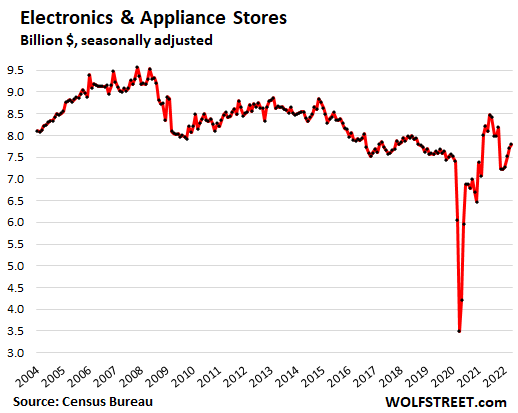Americans are in a bad mood, but that hasn’t dampened their spending: retailer generosity, especially some retailers
Retail therapy in bars and restaurants, cannabis shops and e-commerce? Other retailers aren’t so lucky.
By Wolf Richter for WOLF STREET.
Retail sales rose 0.9% in April from March after rising 1.4% in March from February to $678 billion, and were up a seasonally adjusted 8.2% from a year earlier, the Commerce Department reported today. Retail sales are sales of goods only, not services. And for months we have seen a widespread shift in consumer spending away from goods and back to services, where spending had collapsed during the pandemic but is now picking up sharply.
These retail sales today confirm this trend: Despite the shift in spending towards services, consumers are still spending huge sums on goods and retail sales growth has been close to the rate of inflation, with “real” growth (adjusted for inflation) trending down since inflation-adjusted spending on services more than offsets this.
Consumers are in a bad mood but haven’t reined in their spending.
Rampant inflation has outstripped income growth for many Americans, and they’re also shifting spending to services. And yet retail sales have continued to grow, including e-commerce sales. In terms of shifts, what’s intriguing is that there’s been a big boom in bars and restaurants and in various businesses, most notably cannabis retailers — where sales have far outpaced inflation.
This jump in sales comes despite consumer sentiment falling to a decade low in May, according to the University of Michigan Consumer Survey. Overall sentiment was weighed down by concerns about raging inflation, which has spread across all sectors of the economy and is hitting consumers every day (data from the St. Louis Fed and University of Michigan Survey of Consumers):

Shopping Spree? It’s as if consumers are trying to overcome their sadness and anger over inflation with classic retail therapy to make them feel better — and they’re doing it in bars and restaurants, specialty stores, including cannabis stores, and e-commerce. Other retailers aren’t so lucky.
Sales at new and used car and parts dealers, the largest retail category, rose 2.2% in April from March to $132 billion, seasonally adjusted, but down 1.7% year over year. Used car prices have been falling month-on-month, although still much higher than a year ago, while new car prices have continued to rise at a record pace as new car dealers are woefully low on inventories. And retail sales dollars are the result of this mix:

Sales at e-commerce and other “non-store retailers” rose a seasonally adjusted 2.1% in April from March to $107 billion and was up 12.7% year-on-year. This is the second largest retailer category and includes the e-commerce operations of traditional brick-and-mortar retailers like Walmart:

Grocery and Beverage Stores: Revenue for the month fell a seasonally adjusted 0.2% to $77 billion but was still up 7.1% year over year, driven solely by price increases:

Gastronomy and drinking establishments: Sales at these bars, restaurants, coffee shops, cafeterias, etc. were up a seasonally adjusted 2.0% for the month to a record $84 billion and up 19.8% year over year. This growth rate is almost 3 times the CPI ‘eating out’ inflation rate (7.2%), which indicates that people are going out to indulge and enjoy themselves, perhaps drowning their bad moods with the appropriate liquidity, and are spending heroic amounts of money to do so it.

Convenience Stores: Sales were basically flat at a seasonally adjusted $57 billion this month, up just 0.8% from the stimulus triggered in April a year ago. Walmart and Costco belong in this category, but department stores do not.

gas stations: Revenue for the month fell 2.7% to a seasonally adjusted $62 billion due to falling gasoline prices. Year over year, revenue was still up 36.9%, solely due to the year over year increase in gasoline prices.

Building materials, garden supplies and equipment stores: Sales were roughly flat for the month at $43 billion, up 1.7% for the year from Stimulus Miracle April:

Clothing and Accessories Stores: Revenue increased 0.8% month-to-month and 8.0% year-on-year to $26 billion, on a seasonally adjusted basis:

Various retailers (including cannabis stores): Revenue for the month rose 4.0% to a record $15.9 billion (seasonally adjusted) and was up 19% year over year. This category tracks specialty stores, including cannabis stores, which have become one of the hottest trends in brick-and-mortar retail as some of the black market business comes to earth:

Department Stores: Revenue for the month rose 1.1% to $11.5 billion, up 2.9% year over year. Volume decreases were compensated by price increases. Sales are down 42% from the peak in 2000 as this store format has fallen out of favor with Americans, resulting in the closure of thousands of stores and numerous bankruptcies:

Furniture and furnishing stores: Revenue for the month rose 0.7% (seasonally adjusted) to $12 billion, up just 0.8% year-on-year despite price increases:

Sporting goods, hobby, book and music shops: Sales for the month declined 0.5% to $8.9 billion (seasonally adjusted) and declined 5.4% year-on-year:

Electronics and Appliance Stores: Revenue for the month rose a seasonally adjusted 1.0% to $7.8 billion but declined 5.2% year over year. This segment includes only sales at specialty electronics and gadget stores such as Best Buy or Apple Stores. Electronics and home appliances is a big business that spans many types of retailers such as general merchandise and e-commerce retailers, and sales of electronics and home appliances at these retailers are included in their segments (above).

Enjoy reading WOLF STREET and want to support it? Using ad blockers – I totally understand why – but do you want to support the site? You can donate. I appreciate it very much. Click on the beer and iced tea mug to learn how:

Would you like to be notified by email when WOLF STREET publishes a new article? Login here.
![]()


Comments are closed.